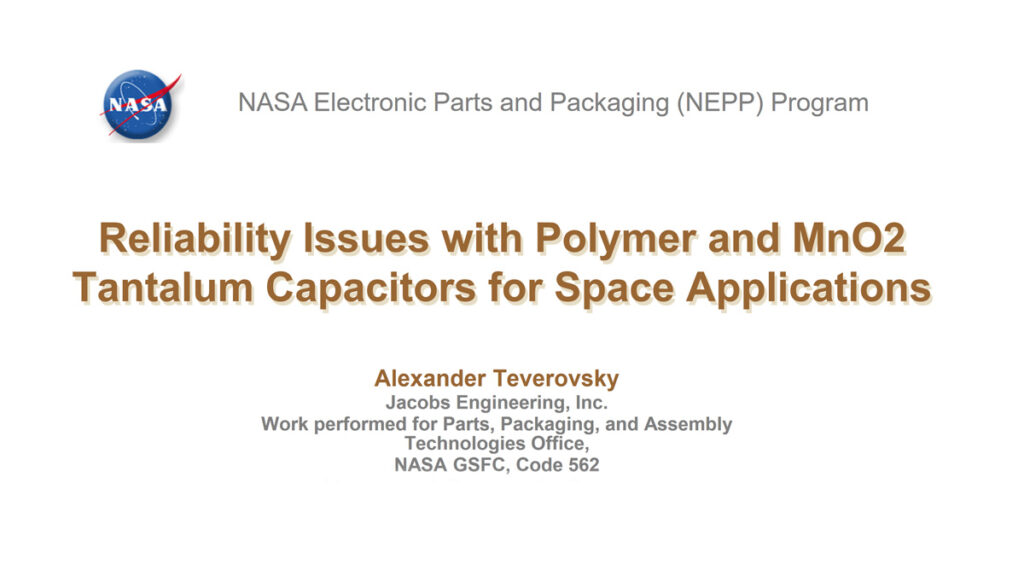Alexander Teverovsky, Jacobs Engineering, Inc, NASA GSFC published presentation that provides a comparative analysis of degradation processes, failure modes and mechanisms in MnO2 and polymer technology tantalum capacitors. Analyzed conditions include effects of vacuum and radiation ,soldering (pop-corning), long-term storage, operation at high temperatures, stability at low and high temperatures, and anomalous transients. Screening and qualification procedures to assure space-grade quality of conductive polymer tantalum capacitors (CPTCs) are suggested.
Advantages and Disadvantages of Conductive Polymer Tantalum Capacitors for Space Applications
Disadvantages
- Variety of materials and processes for cathode formation;
- Desorption of moisture in vacuum can be a benefit or a hazard;
- Intrinsic ESR degradation processes at high temperatures;
- A new phenomena: anomalous transients;
- S&Q system developed for MnO2 capacitors is not sufficient due to new failure and degradation mechanisms.
Effect of Moisture
- CPTCs are more sensitive to moisture compared to MnO2 caps.
- Capacitance variations can reach 40% and DCL >10^4times.
Failures after Soldering
- Pop-corning due to the presence of moisture increases delamination, introduces cracks in package and might damage Ta2O5 dielectric.
- Cracks in packages facilitate penetration of oxygen that increases the rate of ESR degradation in CPTCs.
- Damage to dielectric causes first power-on failures in MnO2 capacitors. The effect has not been observed yet in CPTCs.
- Damage caused by soldering is lot-related.
- Pop-corning issues can be resolved by baking.
- Requirements for MSL testing should include measurements of ESR and surge current testing
- Decrease of C in CPTCs is greater than in MnO2 capacitors.
- Soldering increases ESR in most types of capacitors, but the level of variations is lot-related.
- Soldering results in drying off capacitors by 50 to 93%
Effect of Vacuum
Drying in vacuum has a similar effect as drying in air:
- Decreasing of capacitance and DF;
- A relatively small changes in ESR;
- Variations of C and DF with V;
- Increasing of transient leakage currents, especially at low T.
Life Testing of Tantalum Polymer Capacitors
- No catastrophic failures during life testing and SSLT in 23 lots.
- CPTCs can operate reliably at high T at steady-state conditions.
- Increasing of leakage currents with time is similar to MnO2 caps.
- Post-test DCL measurements might fail the limit.
- Erratic behavior of currents in some samples/lots.
Recommendation for Specification & Qualification
General
- CPTCs should be preconditioned before qualification testing.
- Life testing, HTS, and TS should be carried out using capacitors soldered per specified MSL.
- Testing for FR is not necessary for the following reasons:
- Field failures rarely happen at life test conditions;
- Uncertainty in AFs creates orders of magnitude errors in FR;
- Due to derating, actual FRs are orders of magnitude below the mission requirements;
- Most microcircuits that has been successfully used for space are non-ER components.
Screening (Gr.A) should include:
- Surge current testing. The existing MIL-PRF-55365 requirements limiting maximum current after 1 mseccan be used for CPTCs.
- Burning-in at 105 ºC 1.1VR for 40 hours.
LAT (or gr. B qualification test) should include:
- Life testing at 105 ºC, 1.1VR for 1000 hr.
- High temperature storage test, 1000 hrat 125 ºC.
- Thermal shock, 100 cycles between -55 and +125 ºC.
- Testing after baking at 125 ºC for 168 hours:
- Surge current test at -55 ºC, 25 ºC, and +85 ºC.
- Stability at low and high temperatures (including DCL at low temperatures).
- Power cycling 100 cycles at RT and 0.75VR (5 sec ON/OFF using a power supply capable of rising voltage in less than 1 msec).
Summary
Specific features of polymer compared to MnO2 capacitors include:
- Greater sensitivity to the absence of moisture.
- Intrinsic mechanism of ESR degradation during high T storage or operation in presence of oxygen.
- Anomalous transient phenomena.
- Smaller probability of catastrophic, short circuit failures.
- Increased probability of noisy behavior.
Space systems would benefit from using CPTCs if:
- Selected parts pass space-level screening and qualification testing.
- Operating voltage is deratedto 50% VR.
- Application conditions are analyzed regarding possible effects of AT especially at low T (special testing is necessary for missions requiring cold start-ups).
see the presentation link below:
